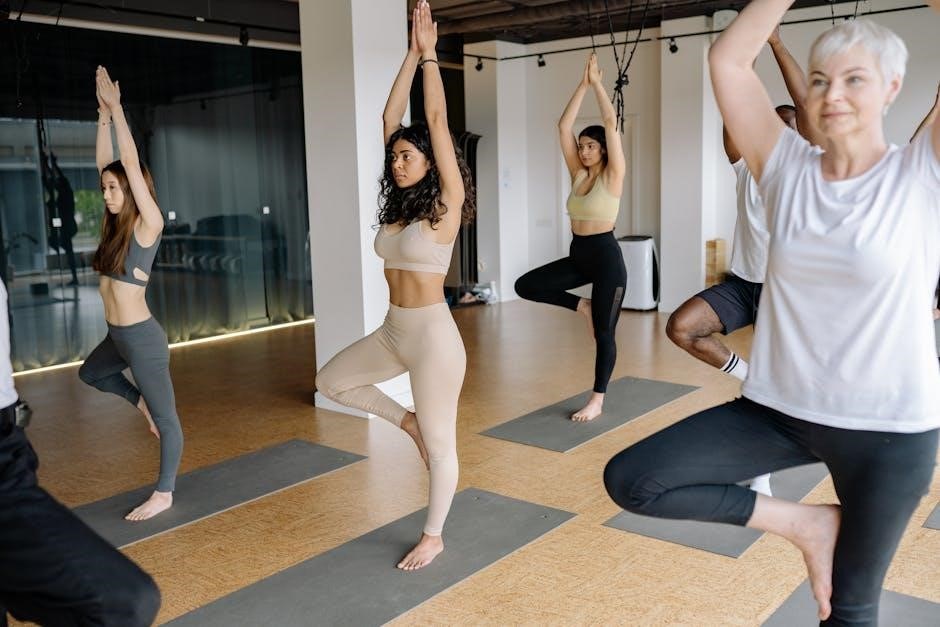Rotator cuff strengthening exercises are essential for shoulder health, preventing injuries, and rehabilitation. Resistance bands offer a low-impact, versatile way to enhance shoulder stability and strength effectively.
Why Resistance Bands Are Effective for Shoulder Rehabilitation
Resistance bands are highly effective for shoulder rehabilitation due to their ability to provide controlled, low-impact resistance without overloading the joints. They allow for precise targeting of the rotator cuff muscles, promoting strength, stability, and flexibility. Unlike free weights, bands enable smooth, continuous tension throughout exercises, reducing injury risk. Their portability and versatility make them ideal for both physical therapy and home use. Additionally, resistance bands can be easily adjusted to accommodate varying strength levels, making them suitable for individuals at different stages of recovery. This makes them a valuable tool for safely and effectively rehabilitating shoulder injuries.

Key Rotator Cuff Strengthening Exercises Using Resistance Bands
Resistance bands provide effective workouts for the rotator cuff, targeting key muscles through exercises like internal and external rotations, and horizontal extensions to improve strength and prevent injuries.
Internal Shoulder Rotation
Internal shoulder rotation strengthens the rotator cuff muscles, particularly the subscapularis. Anchor the resistance band at shoulder height. Hold the band with your arm across your body, then rotate your shoulder inward, pulling the band toward your stomach. Maintain control throughout the movement. Perform 3 sets of 12-15 repetitions. This exercise improves rotational strength and stability, essential for rehabilitation and injury prevention. It’s low-impact, making it ideal for those recovering from shoulder injuries. Proper form ensures targeted muscle engagement without overloading the joint. Consistency helps build resilience in the shoulder, enhancing overall functional mobility and reducing the risk of future injuries.
External Shoulder Rotation
External shoulder rotation targets the infraspinatus and teres minor muscles of the rotator cuff, enhancing shoulder stability and joint health. Anchor the resistance band at shoulder height. Hold the band with your arm extended, then rotate your shoulder outward, pulling the band away from your body. Keep your elbow close to your side and focus on controlled movement. Perform 3 sets of 12-15 repetitions. This exercise improves rotational strength and reduces injury risk. It’s particularly effective for addressing rotator cuff strains or impingement syndrome. Proper form ensures optimal muscle engagement, while controlled movements protect the shoulder joint during rehabilitation.
Horizontal Arm Extension
Horizontal arm extension strengthens the supraspinatus and deltoid muscles, improving shoulder stability and mobility. Anchor the resistance band at chest height. Hold the band with both hands, arms extended forward at shoulder height. Slowly press the band outward, extending your arms horizontally until they are fully extended. Keep your core engaged and maintain a slight bend in your elbows. Avoid shrugging your shoulders. Return to the starting position with controlled movement. Perform 3 sets of 12-15 repetitions. This exercise enhances rotator cuff strength and promotes proper shoulder mechanics, reducing the risk of injury and improving overall shoulder function effectively.
Rear Arm Extension
Rear arm extension targets the posterior deltoid and teres minor muscles, crucial for rotator cuff stability. Secure the resistance band at shoulder height behind you. Hold the band with both hands, arms extended backward at shoulder level. Slowly pull the band apart, extending your arms fully while maintaining a neutral shoulder position. Avoid arching your back or using excessive force. Return to the starting position with controlled movement. Perform 3 sets of 12-15 repetitions. This exercise improves posterior shoulder strength, enhances joint stability, and helps prevent rotational imbalances, making it an excellent addition to a comprehensive rotator cuff rehabilitation program for optimal shoulder health.

Tips for Performing Resistance Band Exercises Effectively
Focus on proper form and controlled movements. Avoid overexertion and prioritize slow, deliberate actions to maximize effectiveness and prevent injury during rotator cuff exercises.
Importance of Proper Form and Technique
Maintaining proper form and technique is crucial when performing resistance band exercises for the rotator cuff. Incorrect movements can lead to ineffective workouts or even injury. Focus on controlled, slow actions to ensure the target muscles are engaged. Avoid jerky or bouncy movements, as they can strain the shoulder joint. Proper form helps prevent muscle imbalances and ensures the rotator cuff muscles are strengthened evenly. Additionally, good technique enhances the effectiveness of each exercise, promoting better rehabilitation and injury prevention. Always prioritize form over resistance level to achieve optimal results and safeguard your shoulder health during rehabilitation.
Progressing Resistance Levels Safely
Progressing resistance levels safely is vital to avoid overloading the shoulder joint and risking injury. Start with lower resistance bands to build foundational strength and gradually increase as your muscles adapt. Monitor your ability to perform exercises with proper form; if you can complete the desired repetitions effortlessly, it may be time to increase resistance. However, never compromise form for higher resistance. Gradual progression ensures continuous strength gains without overexertion. Additionally, incorporating variations in exercises can provide further challenges without solely relying on increased resistance, promoting a balanced and effective rehabilitation process for the rotator cuff.
Frequency and Consistency in Workouts
Consistency is key when using resistance bands for rotator cuff strengthening. Aim for 3-4 sessions per week, allowing at least one day of rest between workouts to promote muscle recovery. Begin with 2-3 sets of 8-12 repetitions for each exercise and gradually increase as strength improves. Regularity helps build muscle memory and ensures progressive overload, which is essential for long-term strength gains. Over time, you can add more exercises or increase the number of sets, but maintaining a consistent routine is crucial for achieving and maintaining shoulder health. Avoid irregular workouts, as this can hinder progress and delay rehabilitation goals.

Safety Precautions and Considerations
Always consult a healthcare professional before starting resistance band exercises, especially after an injury. Begin with low resistance, ensure proper form, and perform a thorough warm-up to prevent strain.
Consulting a Healthcare Professional Before Starting
Before beginning rotator cuff strengthening exercises with resistance bands, it is crucial to consult a healthcare professional, especially if you have an existing injury. A physical therapist or orthopedic specialist can assess your condition and determine the suitability of resistance band exercises for your specific case. They can provide personalized recommendations, ensuring exercises are performed safely and effectively. This is particularly important for conditions like rotator cuff tears, shoulder impingement, or adhesive capsulitis, where certain movements may need to be avoided or modified. Professional guidance helps prevent further injury and tailors the exercise plan to your recovery needs and goals.
Warm-Up Exercises to Prevent Injury
A proper warm-up is essential before starting rotator cuff exercises with resistance bands. Begin with gentle movements to increase blood flow and prepare shoulder muscles. Arm circles, shoulder shrugs, and cross-body stretches are effective warm-up exercises. These activities help reduce stiffness and improve flexibility, minimizing the risk of injury during workouts. Spend 5-10 minutes warming up to ensure your shoulders are ready for resistance training. This step is particularly important for individuals recovering from injuries or experiencing shoulder pain, as it helps prevent strain and promotes a safe transition into strengthening exercises.

Choosing the Right Resistance Band for Shoulder Rehab
Selecting the appropriate resistance band is crucial for effective shoulder rehabilitation. Consider resistance levels, comfort, and durability to ensure proper support and progress in strengthening exercises.
Factors to Consider in Selecting Resistance Levels
When choosing resistance levels for shoulder rehab, consider your fitness level, injury severity, and exercise goals. Start with lighter bands to avoid overloading joints, ensuring controlled movements. Gradually increase resistance as strength improves, maintaining proper form. Opting for adjustable or progressive resistance bands allows for tailored workouts. Additionally, bands with handles provide better grip and comfort during exercises. It’s essential to balance challenge and safety to promote healing and strength without risking further injury. Consulting a physiotherapist can help determine the most suitable resistance level for your specific rehabilitation needs.
Benefits of Using Resistance Tubes with Handles
Resistance tubes with handles offer enhanced comfort and grip, reducing hand fatigue during exercises. The handles provide better control, allowing for precise movements and proper form. This makes them ideal for shoulder rehabilitation, as they minimize strain on the wrists and hands. Additionally, resistance tubes with handles are versatile, enabling a wide range of exercises targeting the rotator cuff and surrounding muscles. They are also easy to transport, making them a convenient option for home or travel workouts. Overall, resistance tubes with handles combine functionality, comfort, and effectiveness, making them a popular choice for shoulder strengthening and rehabilitation exercises.
Resistance bands are a powerful tool for maximizing shoulder health, offering a low-impact, effective way to strengthen the rotator cuff and surrounding muscles. By incorporating these exercises into your routine, you can enhance stability, flexibility, and overall shoulder function. Consistency and proper form are key to achieving optimal results. Whether you’re recovering from an injury or aiming to prevent one, resistance bands provide a safe and versatile solution. Combine them with professional guidance for a tailored approach, ensuring long-term shoulder wellness and resilience.
